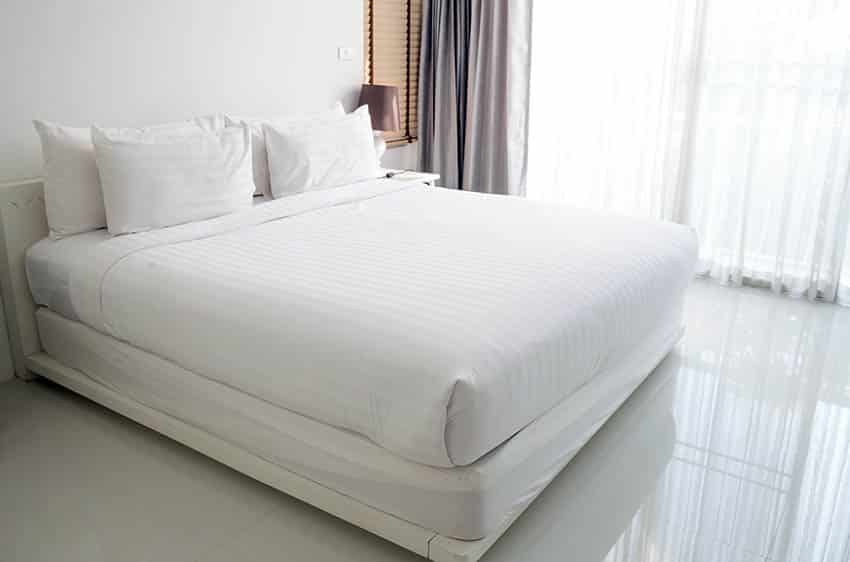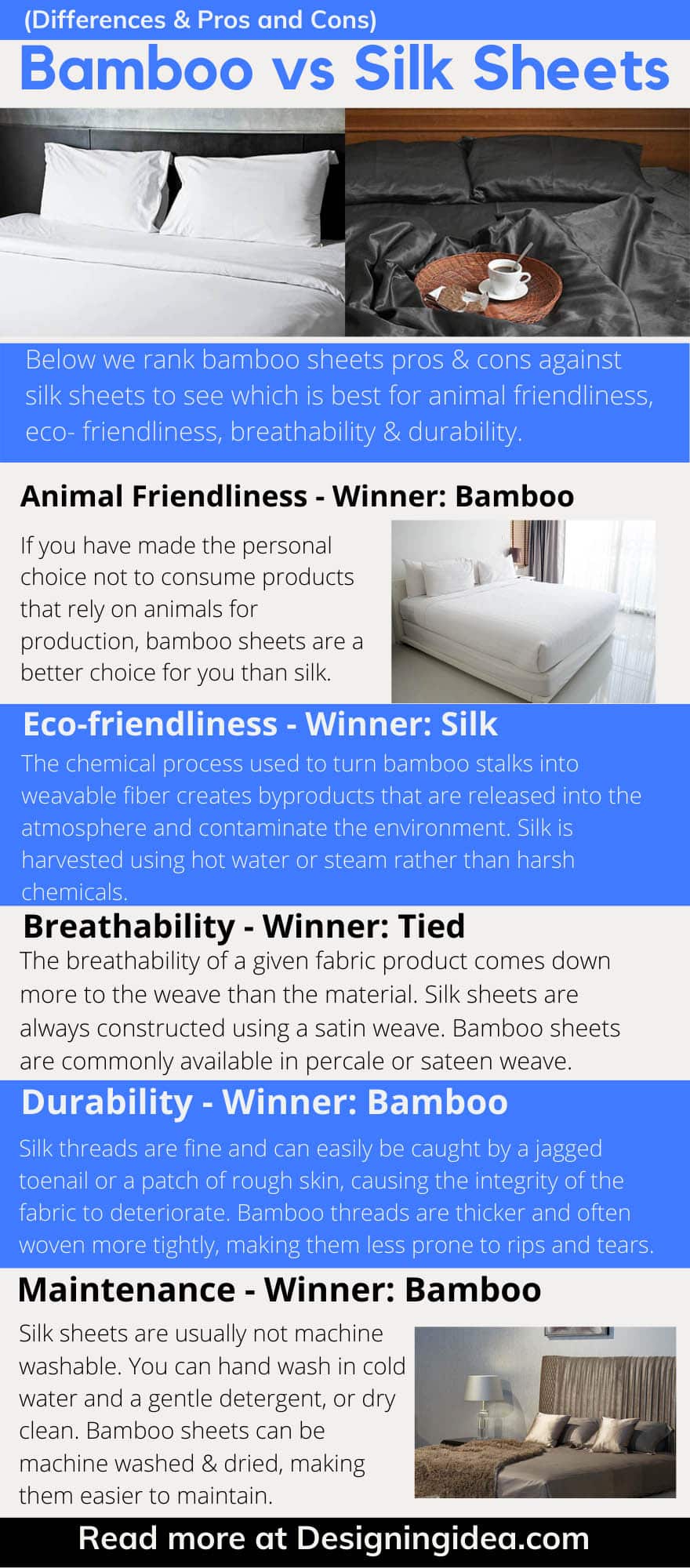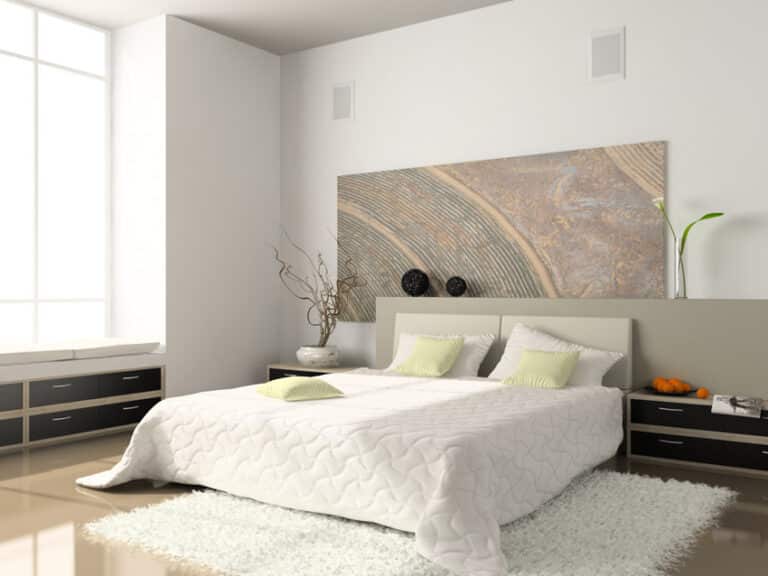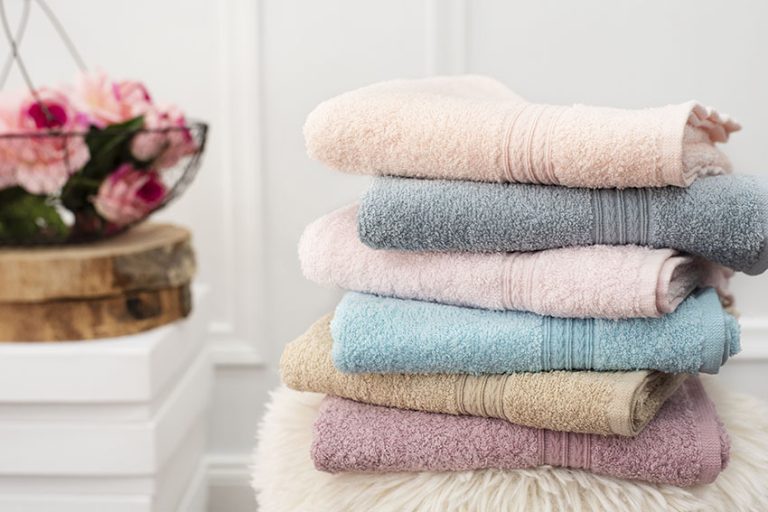Bamboo vs Silk Sheets (Differences & Pros and Cons)
Here we share our comparison of bamboo vs silk sheets, including their pros and cons, cost, and which is best for your bedroom design.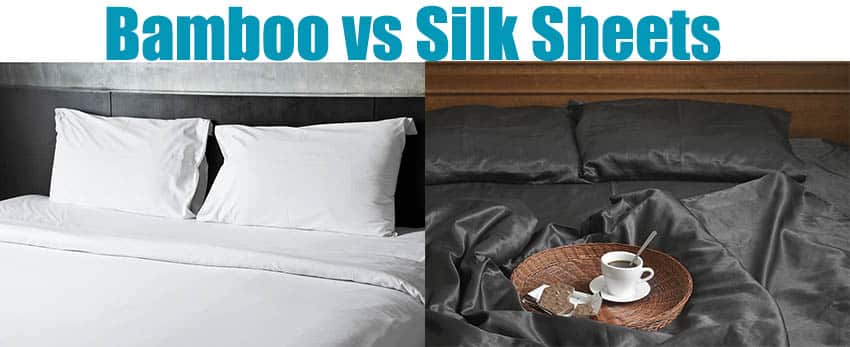
Bamboo and silk fabrics are known to be soft, touchable, and luxurious. If you’re ready to invest in a set of silky smooth bedding but aren’t sure which fabric to choose, you’ve come to the right place.
First, we’ll discuss the differences between these two fabrics. Then, we’ll compare and contrast them in all the most important categories. [toc]
What Are Silk Sheets?
Silk is an incredibly strong and smooth fiber created by an insect called the silkworm. Silkworms spin a single thread to make their cocoons. When finished, silkworm harvesters dissolve the cocoon, which is then processed and turned into commercial silk thread.
The fabrics woven from silk thread are the softest and most luxurious bedding products on the market. Real silk sheets will be soft and touchable, not slippery.
What Are Bamboo Sheets?
To make bamboo fabric, the stalks of the plant are harvested. A chemical process called viscose dissolves the stalks and allows cellulose to be extracted. The cellulose is spun into fibers, which are then woven into fabric.
Bamboo vs Silk Sheets Pros & Cons
Here we rank bamboo sheets pros and cons against silk bedding to see which is better for animal friendliness, eco- friendliness, breathability, durability and cost.
Animal Friendliness
Winner: Bamboo
As we discussed above, silk comes from silkworms. Domesticated silkworms have been bred for production for thousands and thousands of years.
Selective breeding has led to changes in this species that make them unable to survive in the wild. If you have made the personal choice not to consume products that rely on animals for production, bamboo fabrics are a better choice for you than silk. No animals are involved in the production of its fabric.
Eco-friendliness
Winner: Silk
Both materials are natural fabrics that will biodegrade over time.
Bamboo is often touted as an eco-friendly raw material due to the astonishing growth rate of the rigid grass.
Growing up to two feet in a single 24 hour period, it would be easy to succumb to the idea that bamboo sheets are environmentally neutral.
Unfortunately, this isn’t the case. The chemical process used to turn these plant stalks into weavable fiber creates byproducts that are released into the atmosphere and contaminate the environment. Silks are harvested using hot water or steam rather than harsh chemicals.
On the other hand, cultivating bamboo does not require the use of pesticides and antibiotics. Sustaining silkworms requires providing them with a steady diet of mulberry leaves, and all those leaves have to come from somewhere.
Mulberry trees require some pesticides and fertilizers, but not as many as a plant like cotton.
Breathability
Winner: Tied
The breathability of a given fabric product comes down more to the weave than the material.
Bedding made of silks is always constructed using a satin weave. Bamboo fabrics are commonly available in a soft percale or sateen weave.
Percale is a tight weave, meaning not much air gets through it, and yet percale bamboo sheets have a reputation for breathability.
How can this be? Because bamboo is a heat-wicking material, it helps regulate temperature and keep sleepers cool. The crispness of the percale keeps these sheets from conforming closely to your body, leading to better air circulation during the night.
When bamboo fibers are woven into a particular pattern, that pattern is called ‘sateen’. When silk fibers are woven into the exact same pattern, it is referred to instead as ‘satin’.
So: same weave pattern, different material, different names. Satin or sateen weave fabrics are much less tightly woven than percale.
This allows more air to flow through the fabric, increasing the breathability, regardless of whether they are made from either material.
Sheets made of silks conform more closely to the contours of your body, which can reduce overall air flow. Additionally, should you perspire during the night, they will likely show perspiration stains in the morning. Bamboo is much more resistant to sweat.
Durability
Winner: Bamboo
Under certain types of strength tests, silks can indeed outperform steel. But it would be misleading to suggest that they are impervious to damage.
Silk threads are so fine that they can easily be caught by a jagged toenail or even a patch of rough skin, causing the integrity of the fabric to deteriorate. Bamboo threads are thicker and often woven more tightly, making them less susceptible to rips and tears.
Ease of Maintenance
Winner: Bamboo
Silk sheets are usually not machine washable, and can never be put in the dryer. You can hand wash them using cold water and a gentle detergent, or take them to the dry cleaner. Bamboo sheets can be machine washed and dried, making them easier to maintain.
Bamboo vs Silk Sheets Cost
There’s no getting around it: silk sheets are much, much more expensive.
A decent set of bamboo sheets can be purchased for around $50, with higher-quality sets retailing up to $150.
When shopping for silk sheets, it is important to consider the origin of the materials. The quality is determined by the diet of the silkworm that spins it.
Wild silkworms eat whatever leaves are available to them, so the threads harvested from the wild have lower quality overall than cultivated material. Sheets made from wild silks start at $300 for a queen-sized bed.
Cultivated silk, also called mulberry, comes from domesticated silkworms. Their diet consists entirely of mulberry leaves.
The products produced from silkworm farms are considered to be the highest quality available. For a queen-sized set of 100% mulberry silk sheets, plan to spend at least $500 and up to $800.
Are Bamboo Sheets Better than Silk?
Bamboo sheets have a distinct advantage over silk in three areas. First, it is considerably less expensive.
They are also more durable, easy to care for, and don’t require special cleaning. And finally, they don’t trap as much heat, making for a cooler and more comfortable sleep.
However, the texture and luxury of silks can’t be imitated or approximated. For some people, the extra cost and maintenance requirements are worth it. For the rest of us, there’s always the alternative.
Bamboo vs Silk Sheets Infographic
For more related content, visit our comparison of bamboo vs cotton sheets to see how they rank. Which do you like better bamboo or silk sheets? Let us know in the comments.

